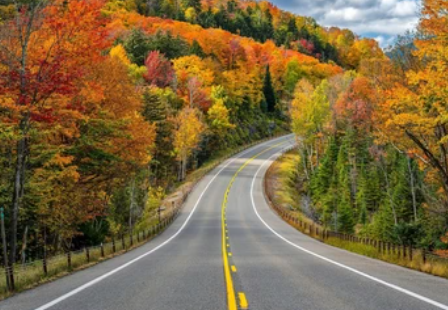Travel These 10 Historic, Scenic U.S. Highways
The best way to see, feel, and live the history of traveling by car and small town America is not by speeding down the boring interstates, but instead, taking your time exploring some of this country's most historic and scenic motor roadways, built and/or cobbled together long ago to foster tourism and travel.
You probably know a few of the highways on this list -- such as Route 66 -- but many others never received the notoriety of America's "Mother Road." Amazingly, there are six named east-west, coast-to-coast old highways, some of which still (partially) exist today as numbered highways, many with historic designations.
U.S. Route 66. Established in 1926, this "super-highway" connected Los Angeles and Chicago -- and many small towns in between, becoming one of the most famous roads in the U.S., including getting immortalized in the hit song, (Get Your Kicks on) Route 66, written by Bobby Troup and covered by many artists. It earned the nicknames, the Mother Road and Main Street of America. While it was removed from the U.S. Highway System in 1985, the original route went through Illinois, Missouri, Kansas, Oklahoma, Texas, New Mexico, Arizona, and California. Many parts of the old Route 66 still exist, some passing through almost non-existent small towns, while other segments have thrived with tourism -- and where travelers can find cozy diners, roadside motels, vintage billboards and advertising signs, cool neon lights, and lots of kitschy Americana attractions. Historic Route 66 is an All-American Road and National Scenic Byway in Arizona, Illinois, New Mexico, and Oklahoma. Find more information at this website: Historic Route 66.
Lincoln Highway. Conceived in 1912 (as the Coast-to-Coast Rock Highway, a graveled road) by Carl Fisher of Indianapolis Speedway fame and formally dedicated in 1913, the Lincoln Highway was the first paved (concrete) transcontinental highway for automobiles, running from Times Square in New York to Lincoln Park in San Francisco, and the best known of several east-west named routes. It was named in honor of President Abraham Lincoln (as suggested by Henry Joy of Packard Motors). Like many others on this list, the highway was replaced with numbed designations in 1926 with the establishment of the U.S. Numbered Highway System. Parts of Lincoln Highway became U.S. 30 (in the east), and U.S. 40 and 50 in the west. Interstate 80 now services this route, though many sections of the old Lincoln Highway still exist close by (while others are totally abandoned). The original route went through New York, New Jersey, Pennsylvania, Ohio, Indiana, Illinois, Iowa, Nebraska, Colorado, Wyoming, Utah, Nevada, and California. Parts of the old Lincoln highway in Illinois are now a National Scenic Byway. Indiana, Iowa, Ohio, and Nebraska also recognize their sections of the Lincoln Highway as historic corridors. Find more information at this website: The Lincoln Highway Association.
U.S. Route 20. Also referred to as Grant Highway as it passes right next to the home of President Ulysses S. Grant in Galena, Illinois, this northern east-west highway offers perhaps the most diversity of any other route across the country. Starting in Boston, Massachusetts, and traveling through the Finger Lakes, the Great Lakes, the Great Plains, the Rocky Mountains, Yellowstone National Park, the Cascade Mountains, and the Willamette Valley, before reaching Portland, Oregon. Covering 3,365 miles, it is the longest highway in the country, though when it first opened in 1926, it terminated at Yellowstone, before being extended in 1940, and reaching its final length in 1960. Much of Interstate 90 parallels U.S. 20, which travels through Massachusetts, New York, Pennsylvania, Ohio, Indiana, Illinois, Iowa, Nebraska, Wyoming, Montana, Idaho, and Oregon. Find more information at this website: The Historic Route 20 Association.
Pacific Highway (U.S. Route 101). A north-south route that mostly follows the coastlines of Washington, Oregon, and California, is often referred to as the Coast Highway, though in Oregon it is the Oregon Coast Highway and in California as the Pacific Highway, and in Southern California as El Camino Real (The Royal Road), which links a series of Spanish missions. In some places, the 101 merges with California State Route 1. Because most of the Pacific Coast is in the public domain, travelers can access many vistas to see craggy cliffs and sandy beaches, condors and whales, great trees such as the red cedars and Sitka spruces in Washington and Oregon and the redwood forests of California -- all the while traveling through small towns and fishing communities. Road-building pioneer Sam Hill was the original force behind the Pacific Highway, which originally began in Blaine, Washington, and continued to the Siskiyou Mountains of northwest California. In 1923, its 1,687 miles of paved highway made it the longest continuous stretch of paved road in the world. Later, the route was expanded north into Vancouver, Canada, and south to San Diego, California. A section in California is a designated All-American Road.
National Old Trails Road. Also referred to as the Ocean-to-Ocean Highway, this route is perhaps the oldest in the National Auto Trail System, established in 1912 through the work of Judge Joseph M. Lowe, and running from Maryland (though some maps have it starting in New York) to California -- similar to the Lincoln and Victory Highways. Much of the route followed the old National Road, Santa Fe Trail, and the Grand Canyon Route. While the roadway disappeared like many other auto trails with the establishment of numbered highways, the National Old Trails Road still exists through numbered highways, such as Route 24, Route 40, Route 56, Route 66 (yes, that one), Route 84, and Route 85. The original route traveled through (new York, New Jersey), Maryland, Virginia, Pennsylvania, Ohio, Indiana, Illinois, Missouri, Kansas, Colorado, New Mexico, Arizona and California.
Dixie Overland Highway (U.S. Route 80). This major east-west- warm-weather driving route that went from Savannah, Georgia, to San Diego, California, was conceived in 1914 by the Automobile Club of Savannah and converted (mostly) to U.S. Route 80 in 1925 when the government decided named roads were too cumbersome and switched to a numbered system. Sadly, the entire segment west of Dallas, Texas, has been decommissioned, though determined drivers can still drive on stretches of the roadway. This highway traveled through Georgia, Alabama, Mississippi, Louisiana, Texas, New Mexico, Arizona, and California.
Overseas Highway (U.S. Route 1.). First completed in 1938, this 113-mile highway that consists of 42 overseas bridges connecting the keys is the southernmost leg of U.S. 1. Also known as the Highway that Goes to the Sea, the highway spans from Miami to Key West in Florida, with large parts built in the former right-of-way of the Henry Flagler's Florida East Coast Railroad, also known as the Overseas Railroad in the keys, offering travelers access to countless coral and limestone islets/keys. A highlight is most certainly the Seven Mile Bridge that spans nearly 7 miles of ocean between Knight's Key (Marathon, Florida) in the Middle Keys to Little Duck Key in the Lower Keys; consider a stop to walk or bicycle the older, parallel bridge that is partially open to non-motorized traffic at Pigeon Key. Motorists love this highway for the scenery and amazing sunrises and sunsets. Declared Florida Keys Scenic Byway, an All-American Road.
U.S. Route 6. Also known in the early days as Roosevelt Highway (until about the 1950s), and, later, as the Grand Army of the Republic (GAR) Highway honoring American Civil War veterans, is yet another east-west highway, which at one time ran from Provincetown, Massachusetts, to Long Beach, California. The first segment of the route was designated in 1925, from Provincetown to Brewster, New York, and then extended to Erie, Pennsylvania. In 1931, the route was further extended to Greeley, Colorado, to, finally, in 1937, to Long Beach -- during which time it was the longest highway in the country. In 1965, California changed its highway system and the segment south of Bishop was decommissioned. The route goes through 14 states, including Massachusetts, Rhode Island, Connecticut, New York, Pennsylvania, Ohio, Indiana, Illinois, Iowa, Nebraska, Colorado, Utah, Nevada, and California. Find more information at this website: U.S. Route 6 Tour Association.
Victory Highway (U.S. Route 40). One of the six major east-west named highways, the Victory Highway was an auto trail created in 1921 by the Victory Highway Association, to mark and commemorate a transcontinental highway dedicated to the U.S. soldiers who died in World War 1. Six Victory Eagle statues originally lined the route, from Atlantic City to San Francisco. The Victory Highway used some of the other existing roadways, including the old National Road (from Maryland to Illinois), the National Old Trails Road and then over the Golden Belt Highway, before following the same route as the Lincoln Highway in California (which followed the California Trail). When the U.S. Numbered Highways system was introduced in 1926, most of the route became U.S. 40. It crossed New Jersey, Delaware, Maryland, Pennsylvania, West Virginia, Ohio, Indiana, Illinois, Missouri, Kansas, Colorado, Utah, Nevada, and California.
Jefferson Highway. Completed in 1916 as part of the National Auto Trail, and named for President Thomas Jefferson, this first transcontinental north-south highway stretched from southern (Winnipeg) Canada to New Orleans, Louisiana. Nicknamed the Pines to Palms route for the varying trees found along the route, this 2,000-mile highway, also called The Vacation Route of America, was replaced in the 1920s with the new highway numbering system, though portions of the highway are still named Jefferson Highway. The U.S. portion went originally through Minnesota, Iowa, Kansas, Missouri, Oklahoma, Texas, and Louisiana. A route through Arkansas was added later. Find more information at this website: The Jefferson Highway Association.
Honorable Mention
Two other historic roadways are the 1920s Old Spanish Trail, which ran 2,750 miles from Saint Augustine, Florida, to San Diego, California, and U.S. Route 83, the "Last American Highway" that has not been replaced by an intereste, running 1,885 miles down the middle of the United States.


Dr. Randall Hansen is an advocate, educator, mentor, ethicist, and thought-leader... helping the world heal from past trauma. He is founder and CEO of EmpoweringSites.com, a network of empowering and transformative Websites, including EmpoweringAdvice.com.
He is the author of the groundbreaking Triumph Over Trauma: Psychedelic Medicines are Helping People Heal Their Trauma, Change Their Lives, and Grow Their Spirituality and the well-received HEAL! Wholeistic Practices to Help Clear Your Trauma, Heal Yourself, and Live Your Best Life.
Dr. Hansen's focus and advocacy center around true healing ... healing that results in being able to live an authentic life filled with peace, joy, love. Learn more by visiting his personal Website, RandallSHansen.com. You can also check out Dr. Randall Hansen on LinkedIn.






